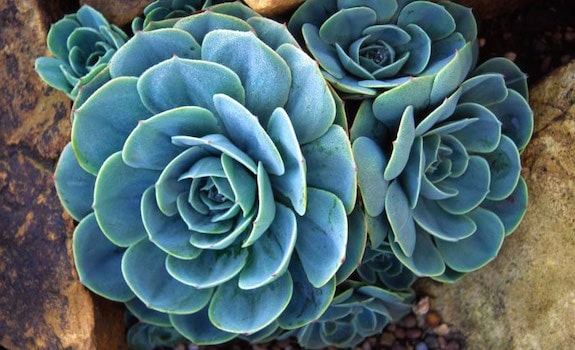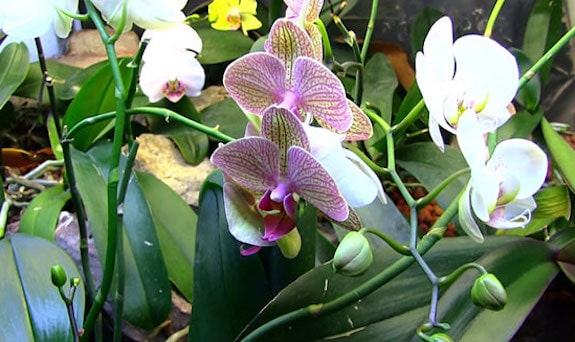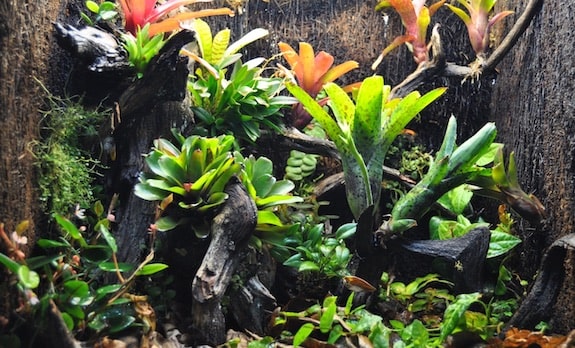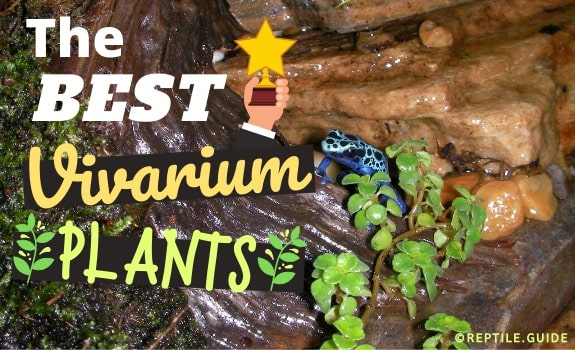A vivarium (opens in new tab) is an enclosed space where you can raise plants or animals, typically used for observation or research. In the reptilian and amphibian world, they are generally either hot (and often dry) terrariums or semi-aquatic paludariums.
And when it comes to using real plants over fake? Let’s just say using live plants is one of the best ways to mimic a natural environment, therefore creating a nearly ideal habitat for whatever creature you are housing.
The type of vivarium plants you choose will vary depending on what reptile you are housing, but you may also have different types of plants in different parts of the habitat.
Curious as to what the very best vivarium plants are for your reptile to enjoy? Simply keep reading!
In This Article
Why Use Natural Vivarium Plants
Live plants for reptile terrariums create security for the animals housed within them. They can climb up high when they want to see, or tuck underneath a large leaf when they want to hide. Animals like the anole love to nibble water droplets off the leaves around them.
Giving them a habitat rich in live reptile-safe plants encourages them to exhibit behaviors you would see in the wild.
It also increases a reptile’s overall health by:
- Reducing stress levels,
- Boosting carbon dioxide in the environment
- Helping maintain the ambient humidity.
And if you are breeding? Well, having a healthy, natural habitat is critical to success.
On a superficial front, living vivarium plants are simply more attractive to look at.
If your vivarium is a focal point in your home, you will really want to plan out the décor because live plants are MUCH more appealing than a barren tank or artificial plants.
Best Plants for a Desert Vivarium
Desert vivariums tend to be rocky or sandy with little other structures just like a natural desert. However, sparse, resilient plants are just as beneficial here as all other plants.
Desert vivariums are almost exclusively for reptiles as amphibians need a moister setting even if they don’t live in the water. Consider the following 3 best plants for a desert vivarium below…
⭐️Pro Tip: Looking for a way to anchor your desert plants in the vivarium? Try keeping them in their own pots as you plant them in the substrate for added stability.
Aloe Vera
This common house plant can grow up to one foot tall, so don’t get discouraged if you buy a small plant and it looks dwarfed in the terrarium.
With the right growing conditions it will start to take up space.
Aloe can be planted directly into the substrate and should not be right underneath the light. Only water it when the soil is dry.
Echeveria

This is a large flowering plant sometimes called the “black prince” or “black Knight.” Echeveria grow wide, low, in rosettes and come in a variety of colors.
While they tend to grow slowly some varieties can get up to 12 inches high and spread 12 inches wide!
✅ Buyer’s Tip: Want something similar to Echeveria but different? Try the Semper Vivum which also works in a desert terrarium!
Frithia Puchra
This is a strange plant that is worth having just because of the way it grows. It’s also called “Fairy elephant feet” but “hairy elephant feet” might be more appropriate.
This succulent has stumpy growth with a light dusting of hair.
It is a little harder to grow than other succulents but if you can devote the extra care to it you might just be rewarded with a pretty purple bloom!
Note: Looking for a place for your frog? Check our guide to the best frog tank and habitat!
Best Plants for a Tropical Vivarium
A tropical vivarium is warm and humid, mimicking the natural habitat of a rainforest. Many reptiles and amphibians love a tropical vivarium, including dart frogs and some tree snakes.
They are not as hot as a desert vivarium, but do have higher humidity.
When considering what live plants for a reptile terrarium are BEST suited for a tropical vivarium, consider these plants above all else:
Ficus
The ficus is such a well-know plant, but people don’t always get the same image in their head when they talk about growing a ficus.
Here are some species by their common name that will hopefully help eliminate any confusion about these adaptable plants.
⭐️Fun Fact: Did you know that the term “Ficus” is actually a genus of plant that includes roughly 900 different species?! From trendy house plants to tropical shrubbery, it’s no wonder why people often imagine different things when they hear the term Ficus.
Ficus Option #1: The Rubber Plant
This is a single trunk tree that when grown in a contained habitat will take on a shrub-like shape. This plant is pretty sturdy for most creatures to scale, but it does need well-draining soil and will need a solid pot to hold it up.
Ficus Option #2: The Weeping Fig
This tree has the potential to be huge in its natural environment, but its size can be stunted indoors. It needs less water and plenty of light.
Ficus Option #3: The Creeping Fig
Like its name implies, this plant will spread and grow (and creep) along a habitat. It likes lots of light and is great for covering up unsightly parts of the aquarium.
It can be like a living blanket that with support my climb a wall or a log.
Ferns
Unlike Ficus, the fern will do just fine in dimmer lighting. However, like the Ficus, the different species all have different perks.
Staghorn Fern
This is probably the MOST tolerant of the ferns when planted in dimmer lighting.
As such, it might be good on the fringe of a habitat or in those that don’t need heavy lighting.
Bird’s Nest Fern
This fern tends to need a bit more light than its brethren but its wide leaves make excellent coverage for reptiles that enjoy hiding.
Boston Fern
This classic is notoriously easy to grow but can be fussy about having too bright lights or too much water.
Put it in an area where the lamps aren’t beating down onto it and gently neglect it.
Orchids

As a houseplant, orchids are famous for being difficult to grow. Visions of people talking to their orchids, trying to coax them to life might come to mind.
However, there are thousands of species of orchids and they aren’t all so challenging.
The orchid might not add a lot of value beyond aesthetics, but when these two examples below are thriving you might actually forget you have anything else in the terrarium but the orchid!
Jewel Orchid (Ludisia Discolor)
This orchid is spectacular when it flourishes. It has leaves that are 2-3 inches long and each spike is 10 inches tall. The entire plant can have at least a two-foot spread with multiple flowering spikes.
Pink Rock Orchid
The flower is the focus of this orchid, which is usually a pinky-purple and clusters together in a multiple bloom.
Best Plants for a Semi-Aquatic Vivarium
Creating a semi-aquatic vivarium is a unique challenge because it is a hybrid between an aquarium and a tropical terrarium; Part of the aquarium is water, like a pond setting, while the other part is dry, yet still humid.
Semi-aquatic vivariums are great for some turtle species and even a few semi-aquatic lizards who like to swim.
This is usually done by building up the terrain on one side of the vivarium and having water on the other side with a buried barrier of plexiglass to keep the sections distinct.
Plants will include the non-aquatic (on land) varieties and the aquatic (in water) varieties.
Best Non-Aquatic Plants
Non-aquatic plants can really be any plants that love humidity and are safe to be around your amphibian (or, perhaps, reptile).
Lucky Bamboo (Dracaena sanderiana)
Lucky Bamboo is a houseplant that can be grown in water or out making it ideal for this situation. While it can be wet, it is better in a humid environment.
This plant is incredibly fun to grow because it can be braided and twisted into shapes and will fit any space that you encourage it to grow in.
Tillandsia
These plants are incredibly popular right now and are often called air plants and sold growing in hanging glass containers.
They capture nutrients and moisture from the air, which makes it very easy to add them to your vivarium in almost any location.
Spider plants
Often a first house plant, these easy growers expand and love moisture but also to need to be well drained.
They might do best hung in the vivarium to absorb moisture from the air and let their leaves dangle down.
Best Aquatic Plants
Like all other, the aquatic plants below will come in many shapes and sizes and have different requirements. The only requirement they have in common being their need for water.
Below are a few easy plants to start with:
⭐️Pro Tip: As a general rule, plants that need more light will grow faster and need grooming, whereas plants that need less light will grow slower and you may never have to groom them.
Java Moss
This plant needs medium-high lighting. Its growth can be slowed by reducing the amount of light it has.
One of the most desirable features of java moss is that it can be trained to grow on things by being attached with fishing line. This includes logs, pots, and even an aquatic wall!
Amazon Sword
This plant grows in clusters with long leaves that are almost fern-like while being underwater.
Its light needs are low-medium, making it a very simple plant to keep and an excellent starter for beginners.
Anubias Nana
This plant has flat, wide dark green leaves and can be grown in little clay pots under the water to keep it from moving around.
It spreads a little, but mostly just bunches and clusters where it is planted.
How to Choose the Perfect Vivarium Plants
When it comes to finding the right plants to thrive in your vivarium, you’ll want to consider a handful of tips before simply going crazy at your local nursery.
Consider the following 6 criteria before adding any new vivarium plants…
Toxicity
Before you begin, read up on your critter and find out what plants are poisonous to your reptile or amphibian.
Buy plants from a reputable supplier that does not use pesticides or insecticides that will hurt your animal.
⭐️Pro Tip: It is a good idea to soak any plants in fresh water for several hours before adding them to your vivarium so that any pollutants will leach off into that water and not your vivarium’s water supply. After all, you can never be too careful!
Climate
Before you start narrowing down your search for the perfect reptile safe plants, you’ll need to first determine what climate you are trying to mimic.
What was the natural habitat of your pet?
Hot and humid or hot and dry? Does the temperature vary throughout the day?
Do you want a milder temperature on one side of the habitat?
Once you have figured out under what conditions your plant needs to survive you can start narrowing down the plants that will work for you.
Light

In an ideal situation you will already know what kind of artificial lighting you are using. This is because the BEST light for your habitat is the light that your reptile or amphibian needs.
If you are using a strong, bright, hot light that casts sharp, edgy shadows, you will need plants that can handle that kind of heat. However, softer, more moderate lights are often flexible with many types of plants.
And if your lamp is designed for heat and doesn’t offer much on the UV spectrum? Well, it’s unlikely you will be able to grow plants under it.
Durability
Is your animal large, heavy, and dragging a long tail?
If so, he will quickly trample small, fragile foliage in his aquarium as soon as you put it in there.
Similarly, if he loves to dig and burrow, you won’t want plant specimens that can’t handle being dug up.
Design
Some thought needs to go into the design of the vivarium.
Is it big enough that you can have a hotter side and a more temperate side?
If so, is that what your pet needs?
In your design are you going to have a variety of plants?
Will some offer shelter and a hiding place while others offer a place to climb?
Consider the function of each plant and where you will place it in the enclosure.
Once you have figured out how you want to use each plant, make a note about how they will grow.
Additionally, try to remember that the taller plants are going to give shade to the smaller plants. As such, you will want the plants that thrive in the most light to be higher than those that need less light.
Limitations
Despite everything above, not all vivariums can handle plants…
Sometimes the heat required to provide a home for your animal is too extreme for living vivarium plants. In these instances, it’s preferable to provide structures that are not alive like pots, dead branches, or artificial plants.
If you are struggling to find plants to stay alive in your setting, either find an expert to ask, or allow yourself to design a vivarium without plants.
Wrapping Up the Best Vivarium Plants
Diving into plants for vivarium is often incredibly overwhelming. However, one of the BEST tips when getting started is to look for a local expert at a hobby event or local shop for instructions.
Follow the advice of someone who has kept the exact reptile or amphibian that you are keeping. You may modify the advice as you learn and grow, but at least you’ll have a baseline to grow from.
And if you ask the right person? Well, you may just be lucky enough to find someone willing to share their plants with you!
